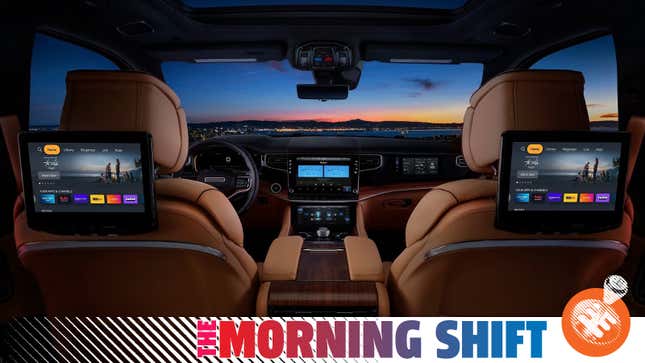
If you look at headlines about Stellantis’ new money-making scheme, things seem pretty innocuous. “Stellantis Bets on Software,” says the Wall Street Journal. “Stellantis launches $23 billion software push,” says Automotive News. Software sounds good, right? Well, something else is at play here: subscription services that keep you paying long after you’ve bought your car. All that and more in The Morning Shift for December 7, 2021.
1st Gear: Stellantis Thinks It Can Make $23 Billion Per Year On In-Car Subscriptions
The company we used to know as Fiat-Chrysler is far from alone in pushing subscription services. VW also quickly comes to mind, but I just want to make clear that this is what looks like an industry trend, not just a Stellantis thing.
But what Stellantis is planning is rather ambitious. From Automotive News:
Stellantis plans to generate around 4 billion euros ($4.5 billion) in additional annual revenues by 2026 and around 20 billion euros ($23 billion) by 2030 from software-enabled product offerings and subscriptions.
Presenting its long-term software strategy on Tuesday, the automaker said it expected to have 34 million connected vehicles on the streets by 2030 from 12 million now.
This is not going to be a “we’ll update it when necessary” kind of thing. This is going to be an offensive, judging by this line from Stellantis:
“We really see software as a growth opportunity, something that can make a huge difference,” [Chief Software Officer Yves] Bonnefont said, adding that updates that could be done every quarter would bolster profit margins.
On the one hand, it will be good for you to be able to upgrade your old car with more modern advances. Hell, even I upgraded my 1974 Volkswagen to have disc brakes not drums. Upgrades aren’t a bad idea. It’s just that expecting to pull in billions of dollars per year on software updates sounds more like a kind of revenue extraction than something done in the interest of the consumer.
2nd Gear: Tesla Has Some Autopilot Camera Problems
Tesla has been leaning into radar-free driver assistance programs, which makes this new not-a-recall all the more interesting. From CNBC:
Tesla is replacing repeater cameras in the front fenders of at least several hundred Model S, X and 3 vehicles made in Fremont, California, although the company has not yet initiated a voluntary recall, according to internal service documents the company distributed in late November.
Internal communications said that the repeater cameras on some Model S, X and 3 vehicles made by Tesla in the U.S. have faulty PCBs, or printed circuit boards, inside. A bad PCB can lead to the cameras losing “electrical continuity” and failing well before those cameras could be reasonably expected to need an upgrade or replacement.
[...]
When the repeater cameras are not working, drivers typically see a black box or choppy video feed on their Tesla’s main display, and they may get alerts that their Autopilot function is limited. Drive Tesla, a Canadian blog for Tesla owners and enthusiasts, wrote about the repeater camera issues in December 2020.
3rd Gear: Carlos Ghosn Is Talking Shit On Nissan’s EVs
Carlos Ghosn is talking a lot of shit for a guy who basically gutted Nissan so badly he had to flee the country of Japan. Anyway, the original Leaf guy is mad that Nissan’s newer EVs lack “vision,” as the Financial Times reports:
Carlos Ghosn has branded Nissan visionless and poorly equipped for the electric vehicle revolution just days after the carmaker he once ran set out a $17.7bn investment plan to take on the likes of Tesla.
[…]
In a series of tirades, unleashed during a press conference as he approached the second anniversary of his escape from Japan in a musical equipment box, Ghosn depicted a company that had lost its spark and misread the increasingly huge bets financial markets were placing on electric cars.
“There is no vision inside Nissan. They have no image about this huge technological transformation that is taking place. They have pitiful results, and they are proud of it,” said Ghosn, who ran the company for almost two decades until his arrest in November 2018 on financial misconduct charges.
I hope that I am this spicy after I become an international fugitive.
4th Gear: Here’s Some More Background On The Japan-Australia-Coal Connection That Keeps Toyota Backing Hydrogen
Every so often someone in the car news world publishes yet another story about how Toyota is stickin’ to hydrogen, as if it is a plan that Toyota alone valiantly pursues. What Toyota is doing with hydrogen does not exist in a vacuum, but as part of a larger national plan to supplant the hole left by nuclear power with cheap coal from Australia, and to green-ify that as much as possible.
Here is the BBC:
In 2010 about one third of Japan’s electricity came from nuclear power, and there were plans to build a lot more. But then the 2011 disaster hit, and all Japan’s nuclear power plants were shut down. Ten years later most remain closed - and there is a lot of resistance to restarting them.In their place Japan’s gas-fired power stations have been doing a lot of overtime. But, as Britain has found out recently, natural gas is expensive.So, the Japanese government decided to build 22 new coal-fired power stations, to run on cheap coal imported from Australia. Economically it made sense. Environmentally, not so much. Japan is now under intense pressure to stop using coal.
Instead of closing the old coal plants and switching to renewables, Japan’s answer is to switch to burning hydrogen or ammonia.
What Japan is doing is using cheap Australian coal to make hydrogen. Using solar energy and electrolysis to make hydrogen is green, but that’s not what Japan is planning on here, per the BBC:
Where is the hydrogen to power Japan zero carbon society going to come from?
The answer is “blue hydrogen”.
Make hydrogen from water using renewable energy and you get “green hydrogen”. The problem is green hydrogen is really expensive.Instead, today most hydrogen is made from natural gas, or even coal. That is cheap but it produces lots of greenhouse gases. However, if you capture those greenhouse gases and bury them in the ground, you are allowed to call it “blue hydrogen”.This is exactly what Japan says it is going to do.
I hope that helps explain why, as other car companies have ditched hydrogen power, Japan’s biggest automaker remains committed. As other national economies run up against the problem of limited fuel sources, we might see more of this plan spreading. Germany and America both have coal.
5th Gear: A Great Report On How Auto Loans Slip Past Usury Laws To Charge 300% Interest
Finally, here’s a great piece from Jalopnik alum Ryan Felton in Consumer Reports on auto loans that would be illegal if it weren’t for car-specific loopholes:
In fact, because auto lending laws vary so much, at least 875,000 borrowers across the country over the past decade have received APRs on auto loans that would appear to be usurious if they’d lived in states with more protective limits, according to a CR analysis of lending data publicly available through the Securities and Exchange Commission. And the real number is almost certainly higher. CR’s analysis was limited to companies that bundle and sell loans to investors as bonds, just a piece of the entire auto loan market.
“A car is one of the most expensive assets most consumers will ever own, second only to a house,” says Chuck Bell, a financial policy advocate at Consumer Reports. “The fact that states permit such egregiously high interest rates for auto loans, in the name of helping people with low credit scores, is completely ridiculous. Without strong interest rate caps, borrowers will be saddled with high-cost loans that set them up for delinquency, default, and repossession.”
The whole piece is a good read.
Reverse: Blue Marble Photographed

From NASA:
This classic photograph of the Earth was taken on December 7, 1972. The original caption is reprinted below:
View of the Earth as seen by the Apollo 17 crew traveling toward the moon. This translunar coast photograph extends from the Mediterranean Sea area to the Antarctica south polar ice cap. This is the first time the Apollo trajectory made it possible to photograph the south polar ice cap. Note the heavy cloud cover in the Southern Hemisphere. Almost the entire coastline of Africa is clearly visible. The Arabian Peninsula can be seen at the northeastern edge of Africa. The large island off the coast of Africa is the Malagasy Republic. The Asian mainland is on the horizon toward the northeast.
Neutral: How Are You?
My horrible project bike is back on the road after a long and winding battle with a snapped bolt. I am exhausted.